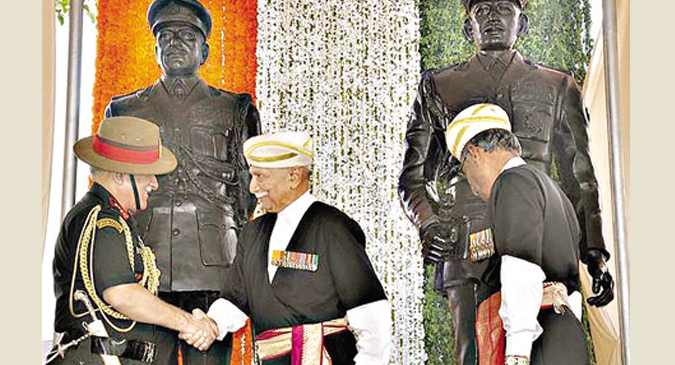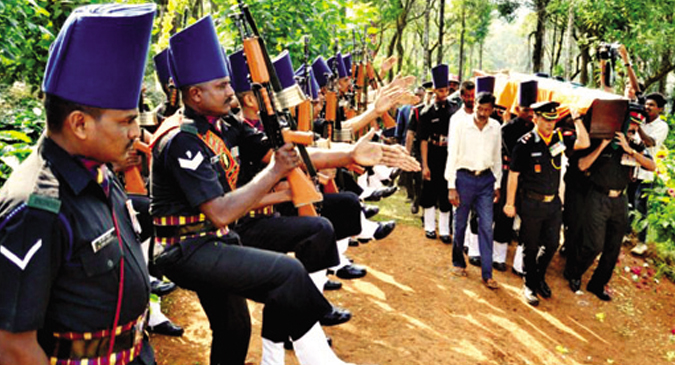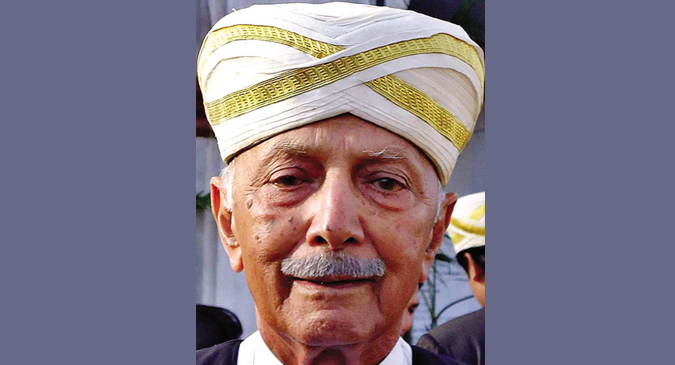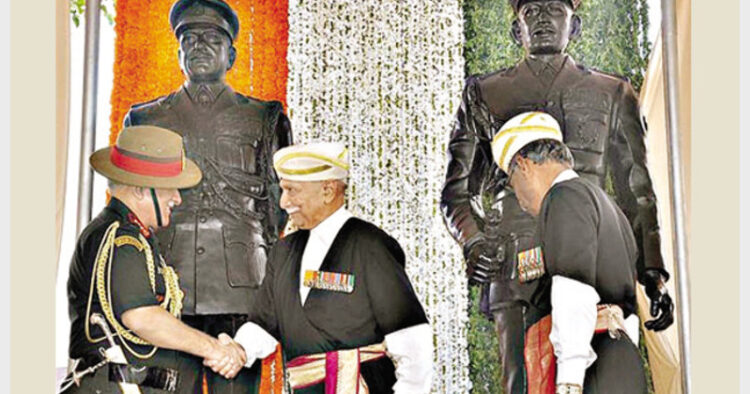Lt. Gen. BC Nanda is a legendary hero of Indian Army. He almost single-handedly saved the Siachen Glacier the world’s highest theatre of battlefield from losing to a very determined Pakistan Army in 1987
n Santhosh Thammaiah
One night in June 1987, a fax arrived at the Delhi Army HQ from the Prime Minister’s Office (PMO). It read, “You might be aware of the latest development. The Prime Minister’s office has called for an emergency meeting in this regard. Senior officers from the Intelligence Departments will be present. You are requested to be present with your staff with a detailed report.”

General Bipin Rawat being greeted by Lt. Gen. BC Nanda (retd) during the unveiling of the statues of Field Marshal KM Cariappa and Gen. KS Thimayya at Gonikoppal
Reading the fax from the PMO, the Army Chief was startled. Well known as the honest General, General Krishnaswamy Sundarji knew about the situation but didn’t have enough time to prepare as the Chief of the Northern Command was supposed to arrive from Udhampur. It was important to sit with him and prepare for the meeting at PMO. Which meant the Army Chief and the Chief of the Northern Command would hardly have any time to sleep.
The next day when the Chief of the Northern Command arrived for the meeting at 10 AM at the PMO, the Army Chief, his deputies, Intelligence Officers, Prime Minister and the Defence Minister were all already seated. After a few minutes of uneasy silence, the Prime Minister began his conversation with a mention of 1949 Karachi Treaty and put forth the agenda for the meeting. The Army Chief and the Chief of the Northern Command looked at each other with an appreciation of his ability to present the situation so eloquently and thoroughly. The way he presented them with a historical reference, the Army staff knew it was time to pull out their weapons from the barracks.

Mortal remains of Lt General (Retd) B C Nanda being carried by military officials to its place of burial in Madikeri, December 13, 2018
The PM said, “We have conducted ourselves in accordance with the 1949 Karachi Treaty. As per the agreement, we have withdrawn our forces from the borders. We have even withdrawn from NJ Point 9842. But now I feel that might have been our first mistake. Because Pakistan is now planning to handover that territory to China. The ties between China and Pakistan are becoming stronger these days. And both their eyes are on the Himalayan Glaciers. What is disturbing is that our key post—Saltoro Ridge—has been occupied by the Pakistanis a week ago. You know chief, Pakistan has named it, ‘Quaid Post’ after Mohammad Ali Jinnah and set up their army post.”
“Yes, Mr Prime Minister, I understand. The strategy for the future will be explained by our Chief of the Northern Command, Lieutenant General Biddanda C Nanda,” said Army Chief Krishnaswamy Sundarji. Lt. Gen Nanda spread out a large map on the table and started presenting, “If we closely examine the new post set up by the Pakistanis, it indicates that they are trying to challenge us because they have violated the Karachi Treaty by occupying our territory. Also they have named it after Jinnah. It is tough to recapture this post, which is located at 21,153ft MSL. But it is possible. We have to recapture it at any cost. Mr. Prime Minister, any country would always have an eye on a place like Siachen Glacier. They will fight to protect even an inch of that land. The one who controls Siachen can control a key part of Asia.” Even though the Prime Minister agreed, the Defence Minister seemed to feel that the nation might misconstrue and point finger at the Congress government then. He showed a sense of irritation at those suggestions, just the way Baldev Singh felt in 1947 and Krishna Menon in 1962. “Lt. Gen. BC Nanda, you seem to be doubtful of capturing it and even if you capture, do you have a plan to protect it?” asked Sundarji.

Two Army officials stood up and said, “Yes, we have an answer.” With that, the meeting came to an end. The army was all set to leave immediately for Siachen. Army General Krishnaswamy Sundarji completely trusted Lt. Gen. BC Nanda. With his direct involvement in the 1962 war, Nanda had the experience of the harsh climate in Siachen Glacier. He had the freedom to pick his team.
- Lt. Gen. BC Nanda ensured higher pay for troops stationed at Siachen and also brought a policy that soldiers can only be posted on short-term postings. And today Siachen is not just the world’s highest army post, but also the most well-equipped
- For Lt. Gen. BC Nanda, Siachen was not only another Himalayan Army post, but he shaped it like a newborn baby. During his tenure as the Chief of the Northern Command, he visited Siachen every month along with his wife to mingle with the soldiers, share food with them and to try to mitigate their loneliness
But Siachen is unlike other war zones, and he knew no such battle had occurred anywhere in the world in the past. At an altitude of about 21,000ft MSL with a freezing temperature below -40 degree centigrade and ice cold winds blowing at 45kmph, the weather was a worse enemy than the Pakistani Army. The second highest glacier on earth and its tributaries which few in the world knew, was approximately 75 km long. But it was impossible for a sepoy to know where it was located and which direction it flows. Interestingly the helicopters themselves had to survive first to ensure that human beings survived in such weather conditions. It was essential to ensure that the fuel didn’t freeze. Every half an hour the guns had to be heated on fire from a kerosene stove or boiled with hot water to prevent it from jamming. The human body becomes weak due to low oxygen. More than recapturing Siachen, the safety of the soldiers in such harsh weather conditions was a more significant concern. But it was inevitable and Army Chief Krishnaswamy Sundarji stationed himself at Udhampur. Only a few days ago, he did have a long discussion with Lt. Gen. ML Babbar. Finally, he asked Lt. Gen BC Nanda where his best 20 was? Instantly, 20 army men walked in briskly on hearing the bell from Lt. Gen BC Nanda’s chamber. It was decided that Col. AP Rai would command the team consisting of Second Lt. Rajeev Pandey, Nayak Subedar Hemraj, NS Bana Singh and others. On June 23rd, the group of 20 left for Siachen in a Helicopter. Their destination was Saltoro Ridge.
On June 23, at 2030 hrs, a few soldiers of Jammu Kashmir light infantry left for Saltoro Ridge. It was pitch dark with freezing temperatures, and the Pakistan army’s “Quaid Post” was only a few metres away. They had to take a circuitous route along the icy mountains at a height of 21,153ft MSL. They had to walk one behind the other and had to cut through treacherous ice. By the time one passes through a short opening, the ice would fill up again. Nayak Subedar Bana Singh was the tenth man, and he had to undergo the agony of seeing 9 of his men, who were ahead of him, die one by one. Few died of gasping for breath as they inched their way closer to the Pakistani Post. A few more succumbed to enemy fire. Second Lieutenant Rajeev Pandey and N.S. Hemaraj were already dead. After noticing their half-burnt body, he immediately called the command for additional reinforcements. The next day Indian Air Force(IAF) helicopter flew with 2 officers, 3 JCOs and 57 soldiers towards Sonam post near Siachen. Thus began Operation Rajiv. The second team took almost 8 hours to cross just 150 meters. They lost two soldiers during the move.
On the of June 26, the first thing Subedar Bana Singh and his team saw at sunrise were men in white uniforms. They were Pakistani soldiers! There was nothing the Indian Army had to wait for. Bana Singh threw the first grenade at the Pakistani bunker. The bunker was blown to pieces. Even before the Pakistani soldiers could realise what was happening, Indian soldiers had started firing at them. There were a few casualties on the Indian side after Pakistani soldiers, who were more in number, began shooting. Col Rai had fallen after taking eight bullets. Subedar Bana Singh and his companions realised that rules of the game had changed, as there were no more orders. They started shooting indiscriminately at the Pak soldiers. A few Pakistani soldiers started running away from the scene of battle. Col. Rai asked Subedar Bana Singh to ‘get at least a few of them alive’ to which he said that the Pakistani soldiers were not his cousins anyway to be saved. In a few minutes, Siachen was cleansed of Pakistani soldiers.
Subedar Bana applied a bandage on Col. Rai’s arm. By then four helicopters landed at Siachin. Army Chief Krishnaswamy Sundarji and Lt. Gen. Biddanda C Nanda arrived. By the sight of it, they realised the intensity of the fight under the steep ice walls. The damage inflicted on Pak was such that Army General asked Subedar Bana Singh “where is the Quaid Post located?” to which, Lt. Gen Biddanda C Nanda replied, “Sir, that is now Bana Singh Post.” He hugged Bana Singh. Even today Bana Singh post exists in Siachen. Even today, Bana Singh and Siachen are synonymous as a symbol of bravery at the world’s highest theatre of warfare.
This is how Lt. Gen Nanda groomed fine soldiers like Subedar Bana Singh for the nation. On that eventful day, BC Nanda may not have been there on the battlefield, but he decided the fate of that battle. BC Nanda, who often said throughout his career that every valour of the brave soldiers should be awarded, sent a recommendation to the government for one Param Vir Chakra, one Maha Vir Chakra, seven Vir Chakras and one Sena medal. After the recapture, he was entrusted with the task of modernising the base at Siachen. He increased the troop size at Siachen. He ensured higher pay for troops stationed at Siachen and also brought a policy that soldiers can only be posted on short-term postings. And today Siachen is not just the world’s highest army post, but also the most well-equipped. For Lt. Gen. BC Nanda, Siachen was not only another Himalayan Army post, but he shaped it like a newborn baby. During his tenure as the Chief of the Northern Command, he visited Siachen every month along with his wife to mingle with the soldiers, share food with them and to try to mitigate their loneliness. Because he always knew India would remain safe only if Siachen is safe.
All through his life, he looked up to his maternal uncle Field Marshal KM Cariappa as his role model, and after his retirement, he decided to settle down in Coorg like his uncle. After his retirement and until the death of FM KM Cariappa, Roshanara, the residence of KM Cariappa had become Lt. Gen. Nanda’s centre of learning. He learnt the importance of preserving nature and the environment of Coorg from Cariappajja. By then Coorg had begun its journey towards mindless development and destruction. Cariappajja’s death was a big relief for many who were into looting the natural resources of Coorg. Now their last obstacle was gone forever. The dance of the demons towards destruction in the name of development had by then begun. Lt. Gen. BC Nanda now brought together like-minded citizens and started to revitalise COORG WILDLIFE SOCIETY. He started environment awareness programs across the district. He donated one acre of his land to Coorg Wildlife Society. He tried to make others realise the importance of Cariappa-Thimmaiah Forum for the overall development of Kodagu. Hundreds of retired army personnel from the district joined the movement under Cariappa-Thimmaiah forum. He invited many Army officers to the district and ensured to sort the problems of the ex-servicemen from the area. Nandajja, as he was lovingly called, had a plan to protect the environment of Coorg through the discipline and dedication of the ex-servicemen of Coorg. But the administration didn’t take notice of BC Nanda’s concern. He was now getting older. He stood by the protesters when thousands of trees were being axed for the high tension wire project to Kerala through Coorg. He demanded that the truth of environmental reports be placed before the people. Unfortunately, nothing worked as per his plan as political interests and mafia started labelling them as Fake (Dhongi) Environmentalists.
The man who recaptured Siachen couldn’t ensure his home district is protected from the powerful mafia within. With such meticulous planning, he could chase the heavily armed Pakistanis at the border, but he could not stop those people who were looting his home district. “The district has reached its threshold, don’t stress the western ghats”, he implored but his cries went unheard. I wonder what were the thoughts in his mind when he left for the heavenly abode on December 12, 2018 at the age of 87. But he must have surely been proud, now that the Prime Minister of India can visit Siachen as and when he wishes to.
(The writer is Bengaluru-based senior journalist)













Comments